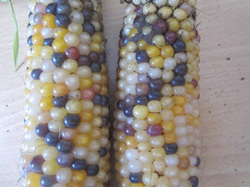 Popcorn - 3 varieties crossed - see below
Popcorn - 3 varieties crossed - see below We are also told to be careful about planting different varieties close together or at the same time, due to the effects of cross-pollination. I'll cover this in more detail in a moment. But first, let's quickly cover the basics of corn pollination for those unfamiliar with it.
How corn is pollinated
| A mature corn plant has two parts of most interest to us in the discussion - the tassels (right), which form at the top of the plant and are where the pollen grains are produced, and the silks (below), which hang from the end of the forming cob, or ear, and which must be pollinated by the pollen. The design is that the pollen will fall downwards with the aid of gravity, and float around a bit with the aid of wind, and come into contact with the silks, pollinating them. Did you know that each strand of silk is attached to one potential kernel of corn? If the silk is pollinated, that kernel will plump up. If not, it won't. This is why poorly pollinated cobs will have many missing kernels, while well pollinated ones will have lovely rows of fat kernels all around the cob. |
Cross-pollination of corn
With other species of vegetables, let's say pumpkins, where cross pollination happens easily - in the case of pumpkins when bees visiting the flowers are carrying pollen from other related varieties - cross-pollination is not of concern to the pumpkin grower if he's only wanting to grow and eat the pumpkins, which will be unaffected, but IS of concern if he's wanting to save seeds from those pumpkins to grow the next year. That is because the seeds that form inside the pumpkins as a result of pollination will carry the DNA of both that plant and the one it was pollinated by, which if it's a different variety means the pumpkins grown from those seeds will not be true to type, and may turn out to be quite different from what the grower wants, even inedible.
However, for plants where pollination produces seed and it's the seed we eat, as in this case corn, then cross pollination by different varieties can affect the "vegetable" itself, as it is the seed we want and eat. (Technically, corn is a grain, not a vegetable). That is, the kernels on the cob are in fact the plant's seeds, and we want them to be true-to-type. If, for example, a sweetcorn plant is pollinated by a popcorn plant, the popcorn will be fine, but the sweetcorn will be have drier, tougher kernels and potentially not be nice to eat. Generally, the tougher/drier types of corn tend to be dominant over the sweetcorn types.
So, to avoid this occurring, gardeners have 3 main choices:
1) Grow only one variety each season
2) Stagger planting so that each different type flowers at different times - this usually means planting 4-6 weeks apart. Further precaution would be to remove any remaining tassels from the first variety before the second one's silks emerge (by with time the first one should have been well pollinated - you could wipe the removed tassels across it's own silks for good measure)
3) Isolate by distance - but since corn pollen can float in the air for huge distances, this is usually impractical in the home garden, though isolating by means of a large structure may help - eg planting one variety on one side of the house, and a different one on the other.
If you don't take any of these measures and grow more than one variety at the same time, then you risk having results different then you hoped for - eg tough sweetcorn. At least that's the theory. I have heard some gardeners say they've grown popcorn and sweetcorn next to each other, and the sweetcorn was fine. However, the science of it says that the sweetcorn, of cross pollinated by the popcorn, will be tougher. Here's the scientific explanation for those who want deeper understanding:
The proper development of corn kernels requires double fertilization — that is, two sperm (carried in the pollen) are required to fertilize an ovule. One of the sperm fertilizes the egg within the ovule, which becomes the plant embryo. The other sperm fuses with other nuclei in the ovule to become the endosperm of the seed, which will develop into a food source for the developing plant. The endosperm makes up the majority of a corn kernel, which is why the genetics of the pollen source matter so much. In contrast, there is very little endosperm in the seeds of other garden plants, which instead put all of their resources into developing the cotyledons (seed leaves). (1)
All of the alleles responsible for sweet corn are recessive, so it must be isolated from other corn, such as field corn and popcorn, that release pollen at the same time; the endosperm develops from genes from both parents, and heterozygous kernels will be tough and starchy. (2). Allele = one member of gene pair, such as will be found in the egg or sperm of a mammal, or the pollen or ovule of a plant. Heterozygous = having two different alleles for the same gene (usually one is dominant and the other is recessive).
But crossing colours can be fun....
The outer coat of the corn kernel is called the pericarp, and the pericarp is where the colour is - eg you can have yellow popcorn or red popcorn, but if you pop them both, the insides of each are white - the colour is only in the pericarp, or hull. The colour of the pericarp is determined only by the genetics of the mother (female plant part, ie ear). This means that the cobs resulting from the immediate cross will be coloured according to the genetics of the plant on which it is growing, but the cobs on plants grown from seeds saved from those are carrying the genetics from both parents and so can show variety.
Let me show you that in practical reality.....
| The year before last, I grew three varieties of popcorn - strawberry/crimson (saved from my previous crop), mini-black (gifted by a Hamilton grower), and yellow (purchased from Kings Seeds). I grew a fair number of each plant, all in the same bed, because I didn't care if they crossed, since all popcorn is popcorn, regardless of colour. At the end of that season, I harvested the popcorn. I had cobs of each of the three distinct colours - a few of those cobs are shown to the right. Last season I chose not to plant any popcorn, as I had plenty stored up and didn't have space in the garden. However, I did notice that some self-sown popcorn was growing next to where the bed of it had been the previous season. Nothing unusual in that; I'd left the popcorn to dry on the plants and had been busy and was slow to getting around to harvesting - some of the cobs were dropping seed before I did so, and I rather expected a few popcorn "weeds." I noticed this particular plant that popped up had red tassels like the strawberry popcorn does, but not the black or yellow ones, so I thought in passing it would produce more strawberry cobs, and then forgot all about it. I never got around to picking it at the end of summer, and eventually the plant died down, and the cobs shed their seed into the grass, or so I thought. Today I was weeding that patch, and found the two cobs still mostly intact, though the end kernels were all sprouting. Here's what they look like (right): Pretty! |
Parents 1 & 2 has two genes for colour - one dominant and one recessive shown as Pp.
Pp crosses with Pp
Possible offspring are:
PP, Pp, Pp and pp
One has two dominant genes, two have one dominant and one recessive, and one has two recessive genes. In theory, 3 of the offspring will be the dominant colour, and one will be the recessive colour.
But in my corn it gets more complicated - there are three colours here, and each colour kernel potentially has a number of different combinations. And of course it will depend which colours are actually dominant. And which plant's pollen pollinates each one.
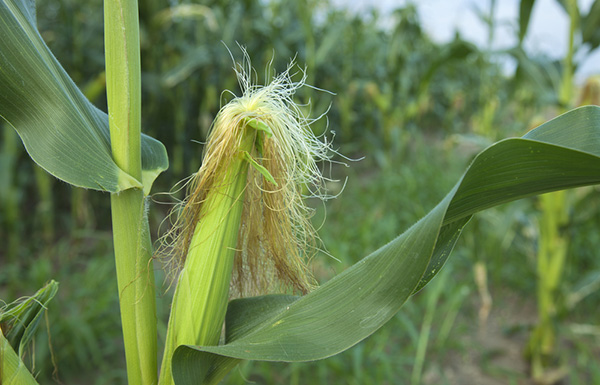
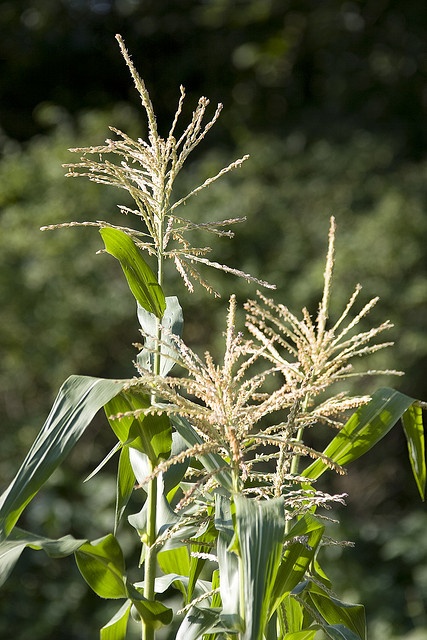
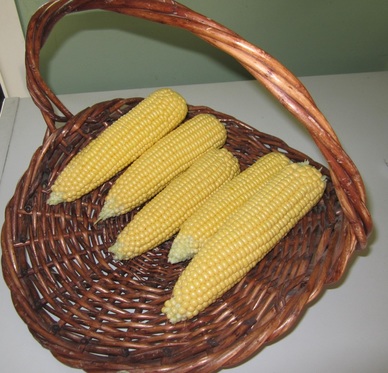
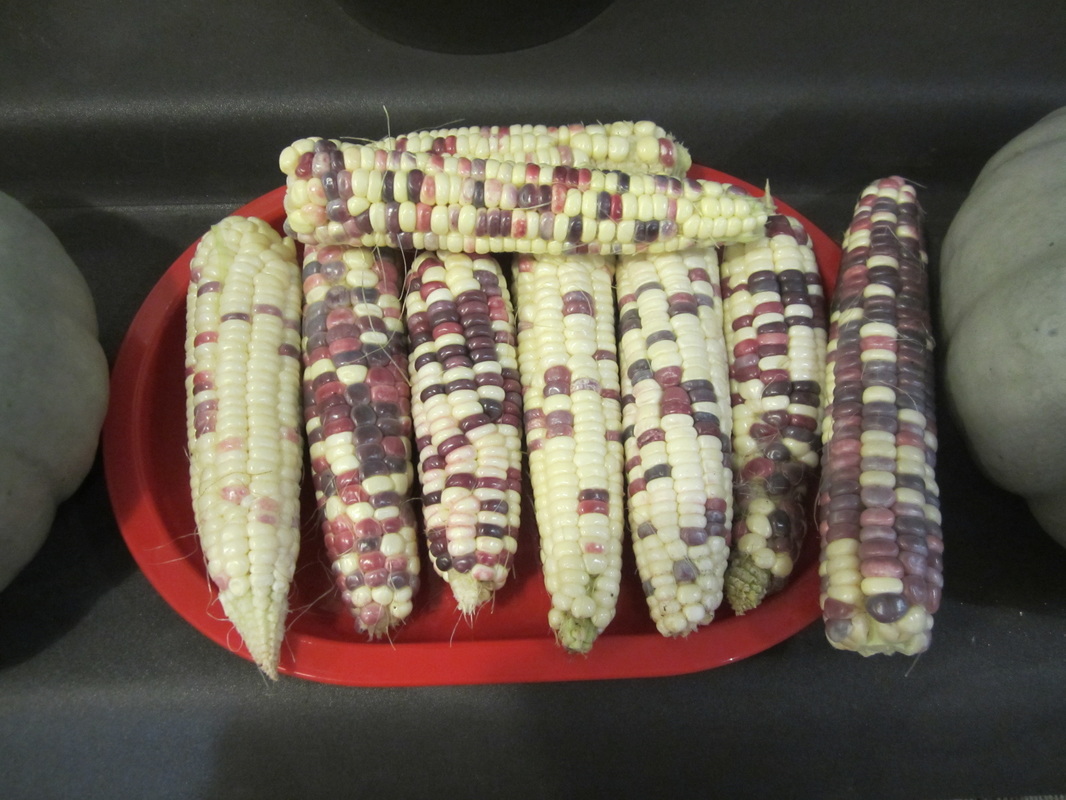
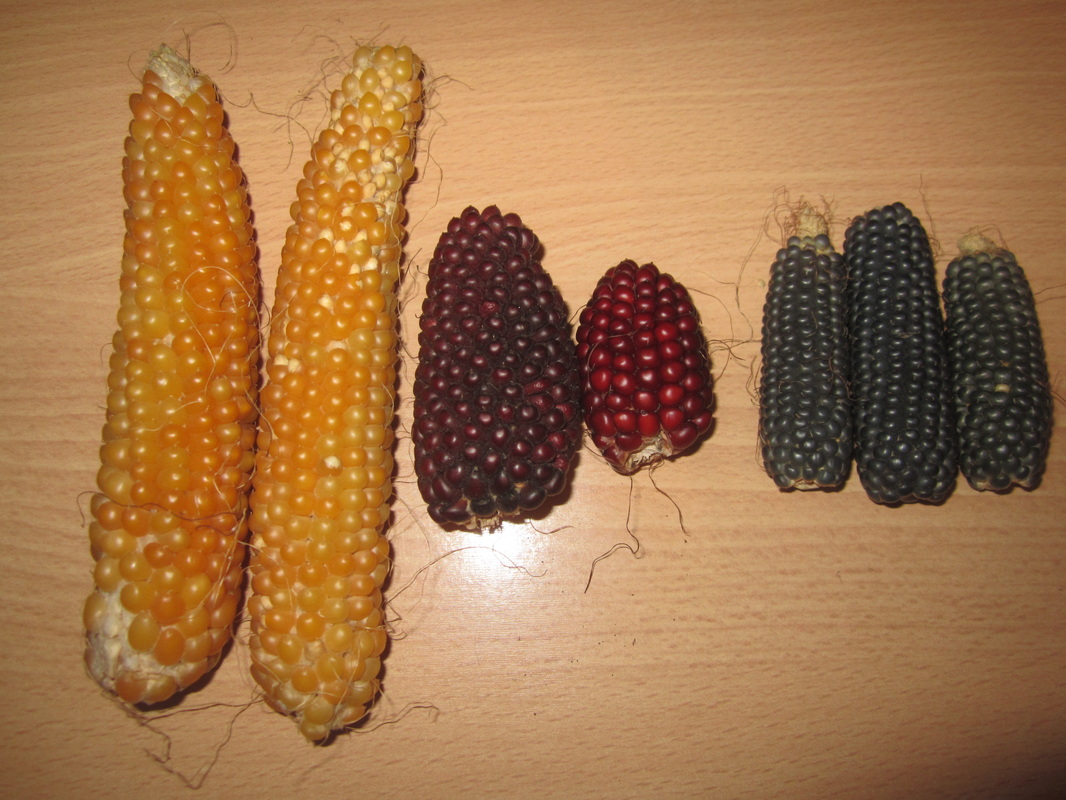
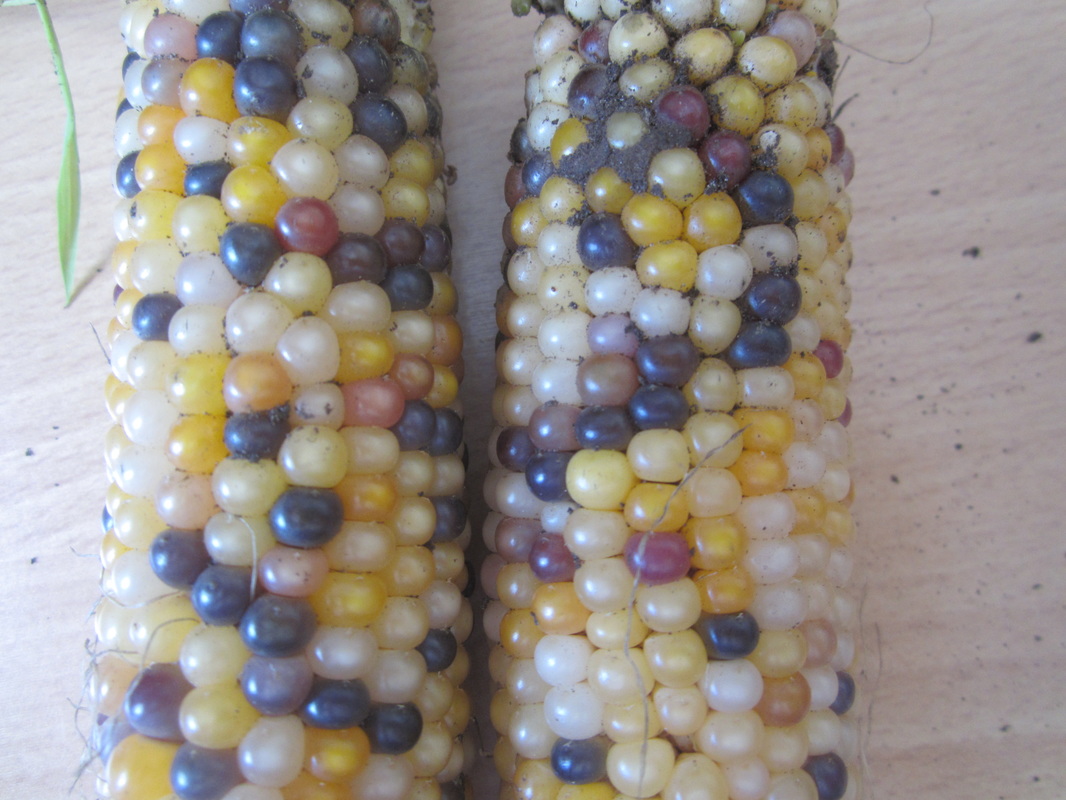
 RSS Feed
RSS Feed
